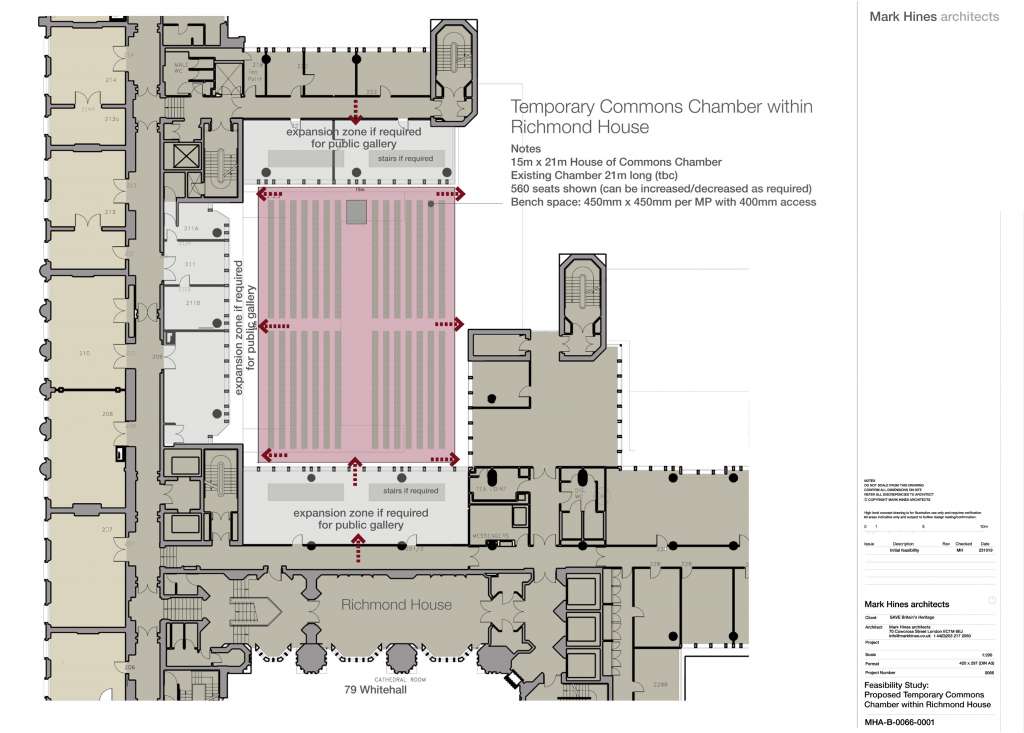PRESS RELEASE: Calling all MPs: how to save £1bn on your accommodation and meet zero carbon targets
29 October 2019
SAVE Britain's Heritage has written to all MPs challenging the cost of the temporary Commons chamber in both financial and environmental terms.
The UK government has set a zero carbon target for the United Kingdom by 2050. The built environment currently contributes some 39% of UK emissions of which 11% are described as embodied emissions relating to the sourcing of materials, construction, repair, replacement and eventual demolition and disposal of buildings.
According to carbon emissions expert Simon Sturgis: “Richmond House is only some 30 years old and represents a significant carbon investment of 16,500 tonnes of CO2, to which would be added the carbon emissions impact of demolition and disposal. To this would also have to be added the embodied carbon emissions cost of any new replacement building.”
He continues: “To demolish such a building on the Government estate would represent a significant waste of resources and result in significant unnecessary additional carbon emissions. This is entirely contradictory to the Government’s stated objectives for achieving net zero by 2050."
Simon Sturgis is Managing Partner of Targeting Zero, Sustainability Advisor to the RIBA Stirling Prize, a CABE Built Environment Expert, and a member of the British Council for Offices Sustainability Group.
SAVE estimates that retaining and retrofitting Richmond House is not only the low carbon option but also the low financial cost option.
In the letter to MPs, SAVE asks them to look at three alternatives:
First, Mark Hines Architects has shown that a temporary chamber can be built in the main courtyard of Richmond House (plan included below). This option was agreed by the Joint Committee and approved by both Houses, but then rejected because measurements showed that an exact replica of the present Commons chamber would not fit. With slight adjustments to the layout and measurements, such a temporary chamber is entirely feasible, as our drawing shows. There is space for circulation at either end, and the division lobbies do not need to be replicated if electronic voting is temporarily used.
A second alternative, drawn up by Hopkins Architects, shows that a demountable temporary Commons chamber can be built in the main courtyard of the Foreign and Commonwealth Office.
A third alternative, drawn up by Foster & Partners, proposes a temporary Commons Chamber on Horseguards Parade, where there is also enough space to accommodate a temporary Lords Chamber and offices if desired.
Each of these options will save the taxpayer at least one billion pounds.
Marcus Binney, executive president of SAVE Britain's Heritage says: “The proposal to permanently demolish Richmond House to meet a temporary need is the most expensive, extravagant, and wasteful public sector proposal for years. The alternative options have been put forward by leading architects who have all designed and delivered major public buildings. It is an outrage that their serious proposals are being brushed aside by the Parliamentary authorities.”
Henrietta Billings, Director of SAVE Britain's Heritage says: "It's increasingly difficult for parliament to justify these eye wateringly expensive proposals. Re-using Richmond house is plain common sense - in both financial and carbon emission terms. We call on Parliament to do the right thing for this and future generations. Save and re-use Richmond House."
SAVE calls for Parliament to be consistent with the Government’s carbon objectives, and calls for a full appraisal of the life cycle carbon costs of rebuilding Richmond House and associated works, as well as the life cycle financial costs.
Click here to see a copy of our letter to MPs and accompanying statement from Simon Sturgis.
Ends.
Note to editors
1. For more information and images contact Henrietta Billings, Director of SAVE Britain's Heritage at office@
2. SAVE Britain’s Heritage has been campaigning for historic buildings since its formation in 1975 by a group of architectural historians, writers, journalists and planners. It is a strong, independent voice in conservation, free to respond rapidly to emergencies and to speak out loud for the historic built environment.


